Analysis of Customer Needs and Supplier Selection for Porcelain Tiles
VerifiedAdded on 2020/04/07
|39
|7799
|464
Report
AI Summary
This report provides a comprehensive analysis of porcelain tiles, focusing on customer satisfaction, design requirements, and supplier selection. It begins with an introduction to porcelain tiles, discussing their characteristics, strengths, and weaknesses. The report then delves into stakeholder analysis and methods for capturing customer needs, including Genchi Genbutsu, telephone interaction, benchmarking, focus groups, and customer complaints. A Kano analysis is used to understand customer preferences and translate them into design requirements, which are further evaluated using Quality Function Deployment (QFD) and Design Risk Analysis (FEMA). The report also covers supplier selection criteria, statistical process control (SPC) for monitoring processes, and problem-solving techniques using SPC and Pareto charts, culminating in a conclusion and references.
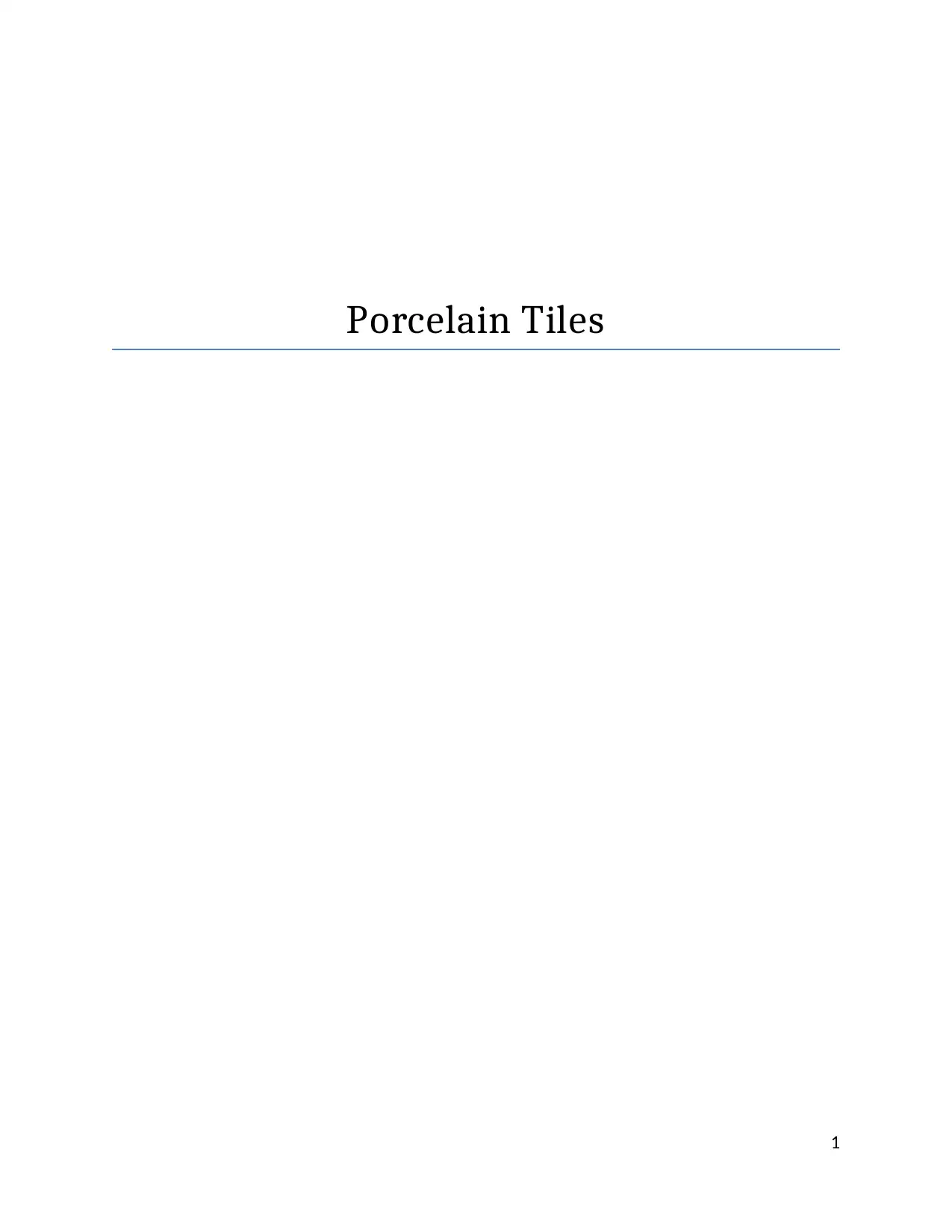
Porcelain Tiles
1
1
Paraphrase This Document
Need a fresh take? Get an instant paraphrase of this document with our AI Paraphraser
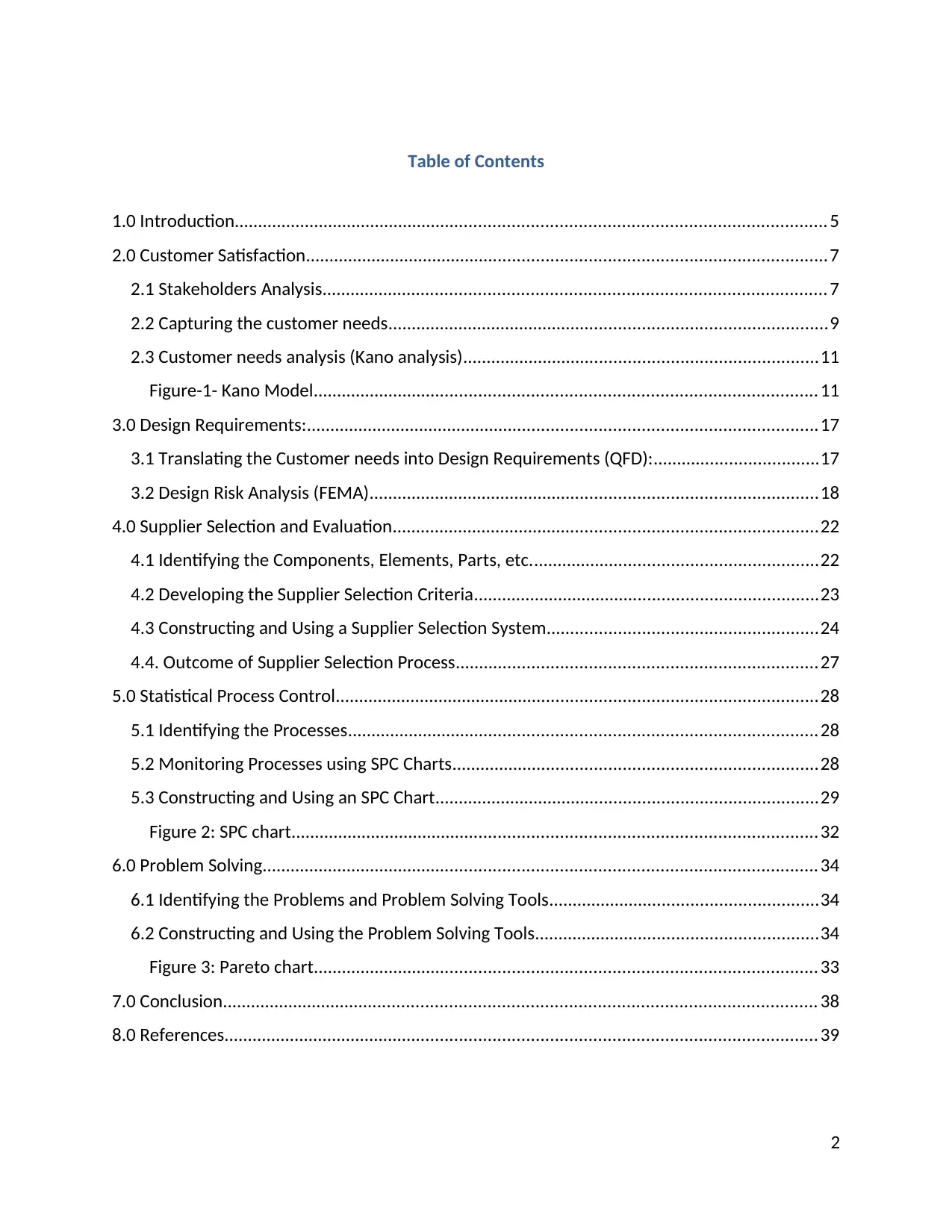
Table of Contents
1.0 Introduction............................................................................................................................. 5
2.0 Customer Satisfaction..............................................................................................................7
2.1 Stakeholders Analysis.......................................................................................................... 7
2.2 Capturing the customer needs.............................................................................................9
2.3 Customer needs analysis (Kano analysis)...........................................................................11
Figure-1- Kano Model.......................................................................................................... 11
3.0 Design Requirements:............................................................................................................17
3.1 Translating the Customer needs into Design Requirements (QFD):...................................17
3.2 Design Risk Analysis (FEMA)...............................................................................................18
4.0 Supplier Selection and Evaluation..........................................................................................22
4.1 Identifying the Components, Elements, Parts, etc.............................................................22
4.2 Developing the Supplier Selection Criteria.........................................................................23
4.3 Constructing and Using a Supplier Selection System.........................................................24
4.4. Outcome of Supplier Selection Process............................................................................27
5.0 Statistical Process Control......................................................................................................28
5.1 Identifying the Processes...................................................................................................28
5.2 Monitoring Processes using SPC Charts.............................................................................28
5.3 Constructing and Using an SPC Chart.................................................................................29
Figure 2: SPC chart...............................................................................................................32
6.0 Problem Solving..................................................................................................................... 34
6.1 Identifying the Problems and Problem Solving Tools.........................................................34
6.2 Constructing and Using the Problem Solving Tools............................................................34
Figure 3: Pareto chart.......................................................................................................... 33
7.0 Conclusion............................................................................................................................. 38
8.0 References............................................................................................................................. 39
2
1.0 Introduction............................................................................................................................. 5
2.0 Customer Satisfaction..............................................................................................................7
2.1 Stakeholders Analysis.......................................................................................................... 7
2.2 Capturing the customer needs.............................................................................................9
2.3 Customer needs analysis (Kano analysis)...........................................................................11
Figure-1- Kano Model.......................................................................................................... 11
3.0 Design Requirements:............................................................................................................17
3.1 Translating the Customer needs into Design Requirements (QFD):...................................17
3.2 Design Risk Analysis (FEMA)...............................................................................................18
4.0 Supplier Selection and Evaluation..........................................................................................22
4.1 Identifying the Components, Elements, Parts, etc.............................................................22
4.2 Developing the Supplier Selection Criteria.........................................................................23
4.3 Constructing and Using a Supplier Selection System.........................................................24
4.4. Outcome of Supplier Selection Process............................................................................27
5.0 Statistical Process Control......................................................................................................28
5.1 Identifying the Processes...................................................................................................28
5.2 Monitoring Processes using SPC Charts.............................................................................28
5.3 Constructing and Using an SPC Chart.................................................................................29
Figure 2: SPC chart...............................................................................................................32
6.0 Problem Solving..................................................................................................................... 34
6.1 Identifying the Problems and Problem Solving Tools.........................................................34
6.2 Constructing and Using the Problem Solving Tools............................................................34
Figure 3: Pareto chart.......................................................................................................... 33
7.0 Conclusion............................................................................................................................. 38
8.0 References............................................................................................................................. 39
2

3
⊘ This is a preview!⊘
Do you want full access?
Subscribe today to unlock all pages.

Trusted by 1+ million students worldwide
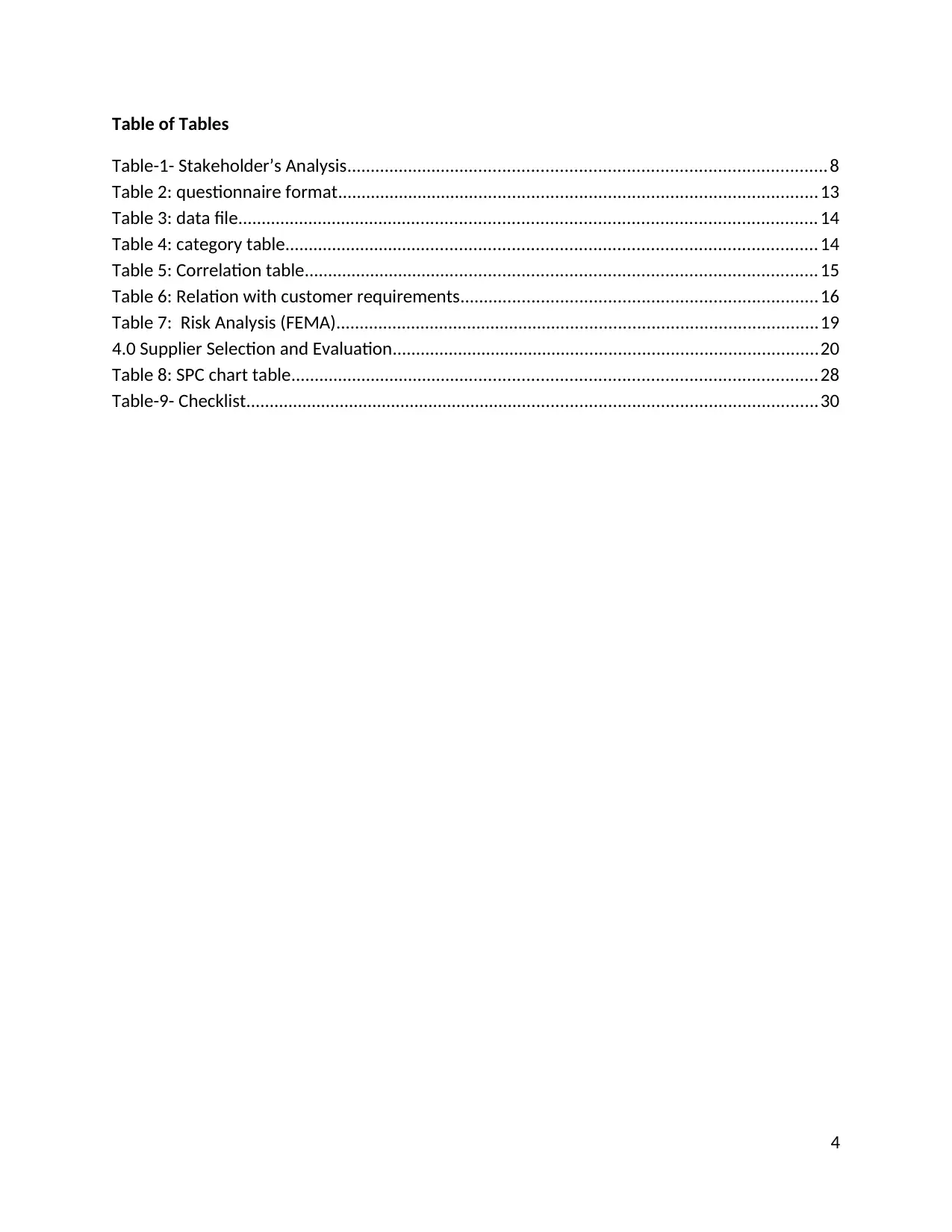
Table of Tables
Table-1- Stakeholder’s Analysis.....................................................................................................8
Table 2: questionnaire format..................................................................................................... 13
Table 3: data file.......................................................................................................................... 14
Table 4: category table................................................................................................................ 14
Table 5: Correlation table............................................................................................................ 15
Table 6: Relation with customer requirements...........................................................................16
Table 7: Risk Analysis (FEMA)......................................................................................................19
4.0 Supplier Selection and Evaluation..........................................................................................20
Table 8: SPC chart table............................................................................................................... 28
Table-9- Checklist.........................................................................................................................30
4
Table-1- Stakeholder’s Analysis.....................................................................................................8
Table 2: questionnaire format..................................................................................................... 13
Table 3: data file.......................................................................................................................... 14
Table 4: category table................................................................................................................ 14
Table 5: Correlation table............................................................................................................ 15
Table 6: Relation with customer requirements...........................................................................16
Table 7: Risk Analysis (FEMA)......................................................................................................19
4.0 Supplier Selection and Evaluation..........................................................................................20
Table 8: SPC chart table............................................................................................................... 28
Table-9- Checklist.........................................................................................................................30
4
Paraphrase This Document
Need a fresh take? Get an instant paraphrase of this document with our AI Paraphraser
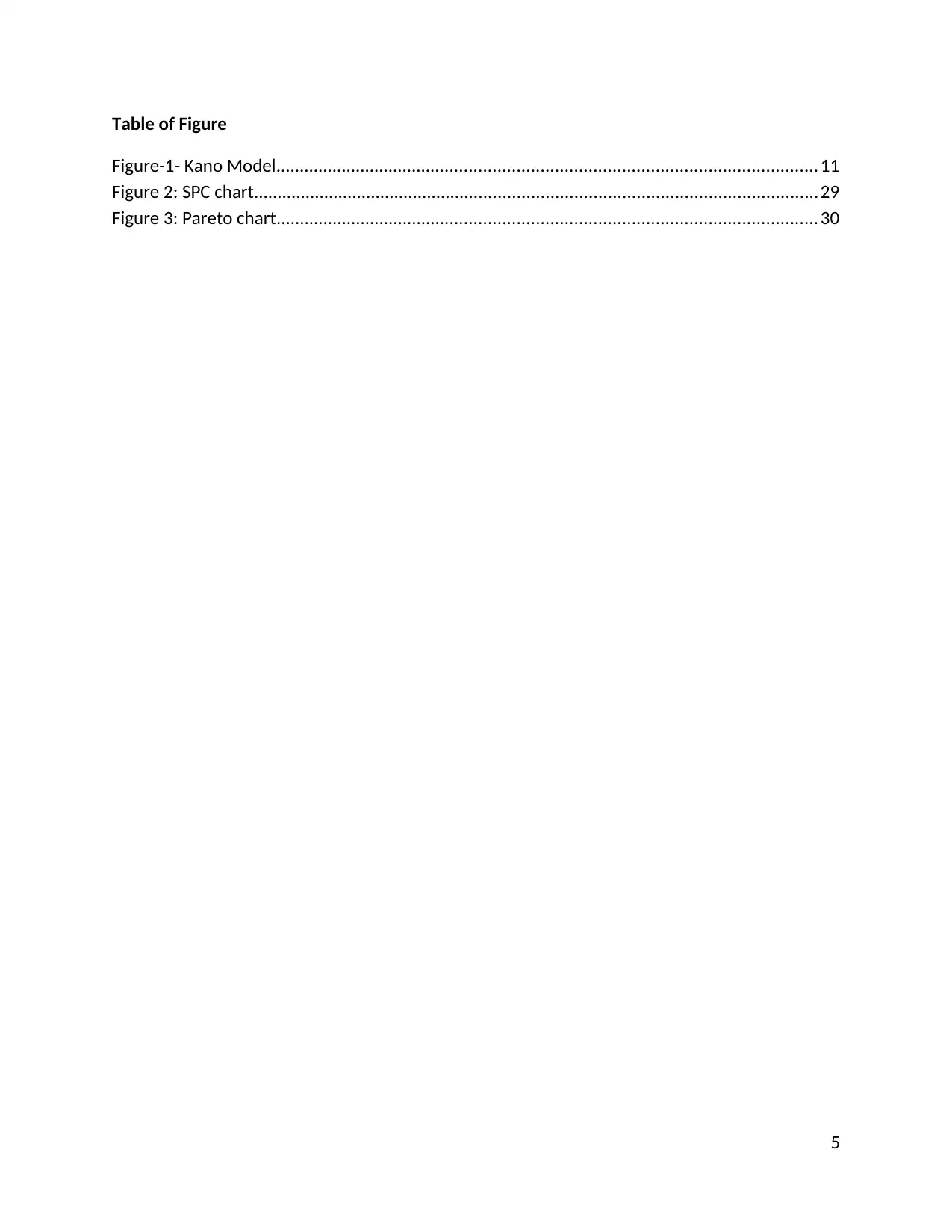
Table of Figure
Figure-1- Kano Model.................................................................................................................. 11
Figure 2: SPC chart.......................................................................................................................29
Figure 3: Pareto chart.................................................................................................................. 30
5
Figure-1- Kano Model.................................................................................................................. 11
Figure 2: SPC chart.......................................................................................................................29
Figure 3: Pareto chart.................................................................................................................. 30
5
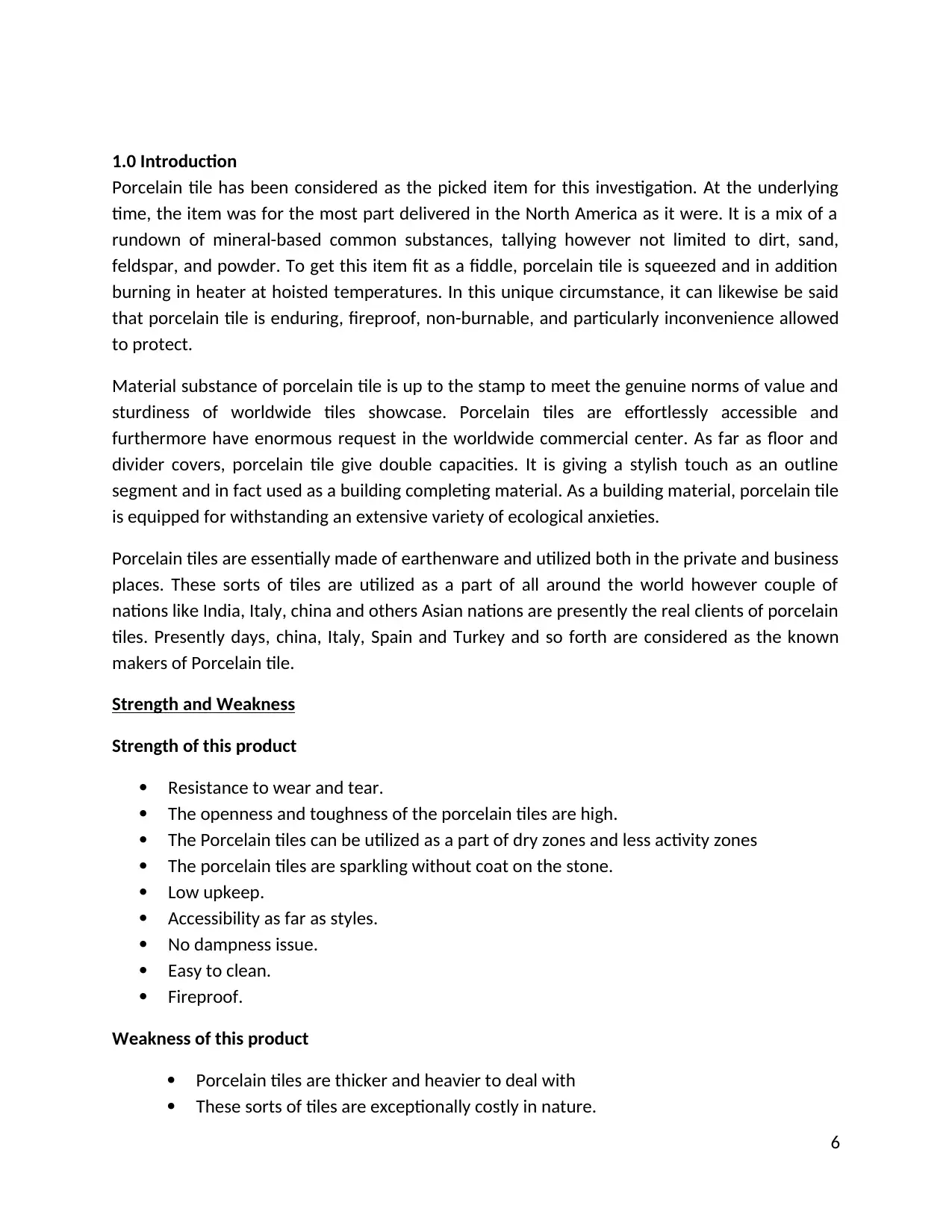
1.0 Introduction
Porcelain tile has been considered as the picked item for this investigation. At the underlying
time, the item was for the most part delivered in the North America as it were. It is a mix of a
rundown of mineral-based common substances, tallying however not limited to dirt, sand,
feldspar, and powder. To get this item fit as a fiddle, porcelain tile is squeezed and in addition
burning in heater at hoisted temperatures. In this unique circumstance, it can likewise be said
that porcelain tile is enduring, fireproof, non-burnable, and particularly inconvenience allowed
to protect.
Material substance of porcelain tile is up to the stamp to meet the genuine norms of value and
sturdiness of worldwide tiles showcase. Porcelain tiles are effortlessly accessible and
furthermore have enormous request in the worldwide commercial center. As far as floor and
divider covers, porcelain tile give double capacities. It is giving a stylish touch as an outline
segment and in fact used as a building completing material. As a building material, porcelain tile
is equipped for withstanding an extensive variety of ecological anxieties.
Porcelain tiles are essentially made of earthenware and utilized both in the private and business
places. These sorts of tiles are utilized as a part of all around the world however couple of
nations like India, Italy, china and others Asian nations are presently the real clients of porcelain
tiles. Presently days, china, Italy, Spain and Turkey and so forth are considered as the known
makers of Porcelain tile.
Strength and Weakness
Strength of this product
Resistance to wear and tear.
The openness and toughness of the porcelain tiles are high.
The Porcelain tiles can be utilized as a part of dry zones and less activity zones
The porcelain tiles are sparkling without coat on the stone.
Low upkeep.
Accessibility as far as styles.
No dampness issue.
Easy to clean.
Fireproof.
Weakness of this product
Porcelain tiles are thicker and heavier to deal with
These sorts of tiles are exceptionally costly in nature.
6
Porcelain tile has been considered as the picked item for this investigation. At the underlying
time, the item was for the most part delivered in the North America as it were. It is a mix of a
rundown of mineral-based common substances, tallying however not limited to dirt, sand,
feldspar, and powder. To get this item fit as a fiddle, porcelain tile is squeezed and in addition
burning in heater at hoisted temperatures. In this unique circumstance, it can likewise be said
that porcelain tile is enduring, fireproof, non-burnable, and particularly inconvenience allowed
to protect.
Material substance of porcelain tile is up to the stamp to meet the genuine norms of value and
sturdiness of worldwide tiles showcase. Porcelain tiles are effortlessly accessible and
furthermore have enormous request in the worldwide commercial center. As far as floor and
divider covers, porcelain tile give double capacities. It is giving a stylish touch as an outline
segment and in fact used as a building completing material. As a building material, porcelain tile
is equipped for withstanding an extensive variety of ecological anxieties.
Porcelain tiles are essentially made of earthenware and utilized both in the private and business
places. These sorts of tiles are utilized as a part of all around the world however couple of
nations like India, Italy, china and others Asian nations are presently the real clients of porcelain
tiles. Presently days, china, Italy, Spain and Turkey and so forth are considered as the known
makers of Porcelain tile.
Strength and Weakness
Strength of this product
Resistance to wear and tear.
The openness and toughness of the porcelain tiles are high.
The Porcelain tiles can be utilized as a part of dry zones and less activity zones
The porcelain tiles are sparkling without coat on the stone.
Low upkeep.
Accessibility as far as styles.
No dampness issue.
Easy to clean.
Fireproof.
Weakness of this product
Porcelain tiles are thicker and heavier to deal with
These sorts of tiles are exceptionally costly in nature.
6
⊘ This is a preview!⊘
Do you want full access?
Subscribe today to unlock all pages.

Trusted by 1+ million students worldwide
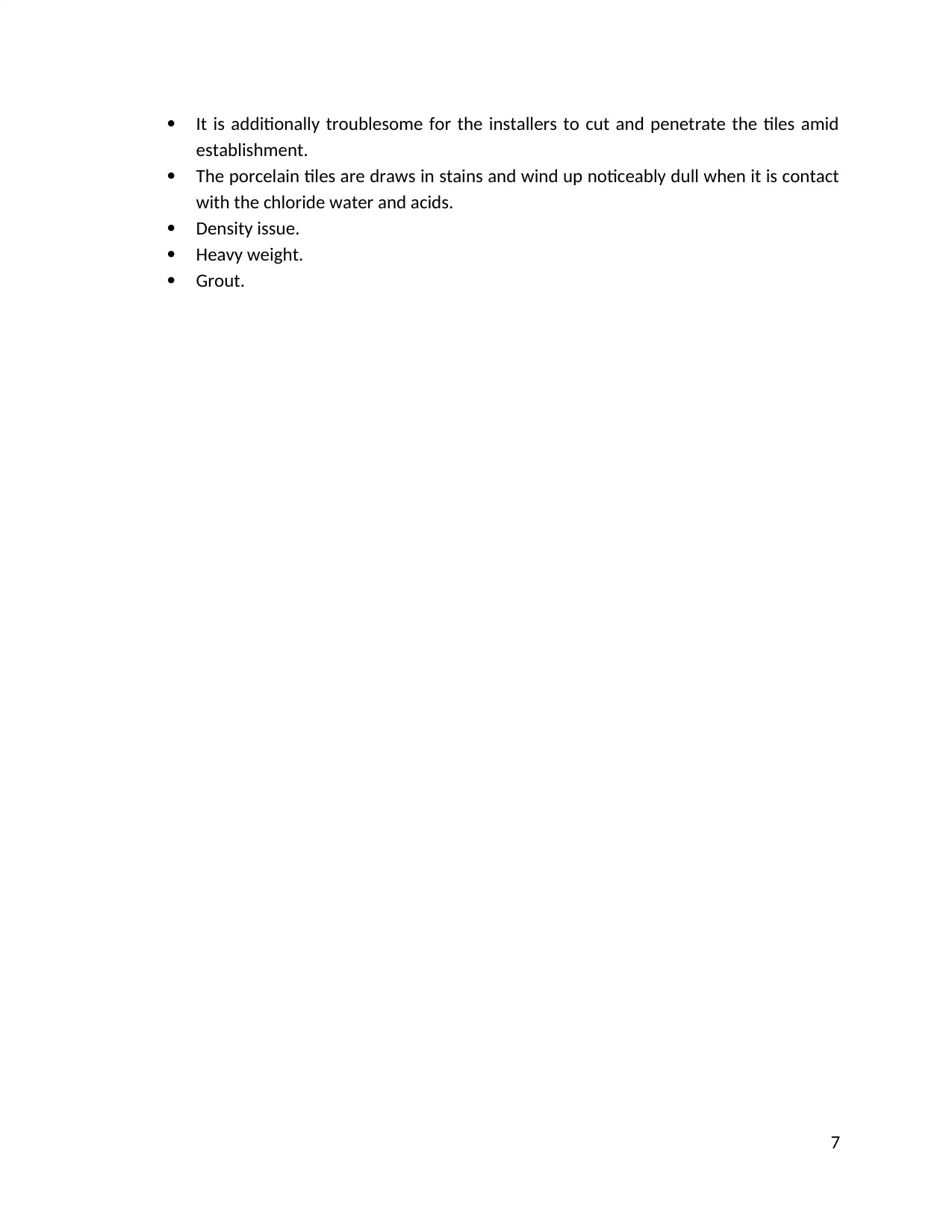
It is additionally troublesome for the installers to cut and penetrate the tiles amid
establishment.
The porcelain tiles are draws in stains and wind up noticeably dull when it is contact
with the chloride water and acids.
Density issue.
Heavy weight.
Grout.
7
establishment.
The porcelain tiles are draws in stains and wind up noticeably dull when it is contact
with the chloride water and acids.
Density issue.
Heavy weight.
Grout.
7
Paraphrase This Document
Need a fresh take? Get an instant paraphrase of this document with our AI Paraphraser
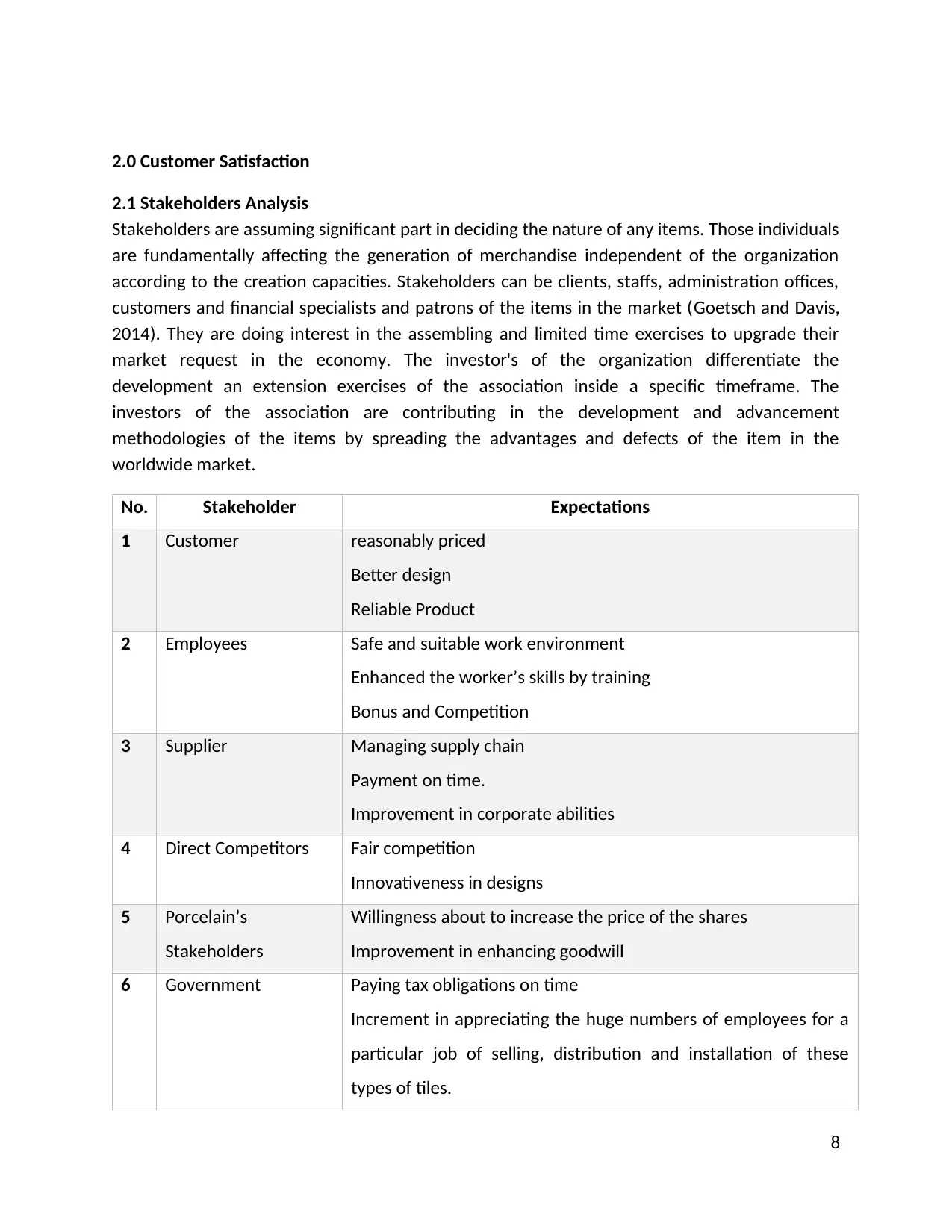
2.0 Customer Satisfaction
2.1 Stakeholders Analysis
Stakeholders are assuming significant part in deciding the nature of any items. Those individuals
are fundamentally affecting the generation of merchandise independent of the organization
according to the creation capacities. Stakeholders can be clients, staffs, administration offices,
customers and financial specialists and patrons of the items in the market (Goetsch and Davis,
2014). They are doing interest in the assembling and limited time exercises to upgrade their
market request in the economy. The investor's of the organization differentiate the
development an extension exercises of the association inside a specific timeframe. The
investors of the association are contributing in the development and advancement
methodologies of the items by spreading the advantages and defects of the item in the
worldwide market.
No. Stakeholder Expectations
1 Customer reasonably priced
Better design
Reliable Product
2 Employees Safe and suitable work environment
Enhanced the worker’s skills by training
Bonus and Competition
3 Supplier Managing supply chain
Payment on time.
Improvement in corporate abilities
4 Direct Competitors Fair competition
Innovativeness in designs
5 Porcelain’s
Stakeholders
Willingness about to increase the price of the shares
Improvement in enhancing goodwill
6 Government Paying tax obligations on time
Increment in appreciating the huge numbers of employees for a
particular job of selling, distribution and installation of these
types of tiles.
8
2.1 Stakeholders Analysis
Stakeholders are assuming significant part in deciding the nature of any items. Those individuals
are fundamentally affecting the generation of merchandise independent of the organization
according to the creation capacities. Stakeholders can be clients, staffs, administration offices,
customers and financial specialists and patrons of the items in the market (Goetsch and Davis,
2014). They are doing interest in the assembling and limited time exercises to upgrade their
market request in the economy. The investor's of the organization differentiate the
development an extension exercises of the association inside a specific timeframe. The
investors of the association are contributing in the development and advancement
methodologies of the items by spreading the advantages and defects of the item in the
worldwide market.
No. Stakeholder Expectations
1 Customer reasonably priced
Better design
Reliable Product
2 Employees Safe and suitable work environment
Enhanced the worker’s skills by training
Bonus and Competition
3 Supplier Managing supply chain
Payment on time.
Improvement in corporate abilities
4 Direct Competitors Fair competition
Innovativeness in designs
5 Porcelain’s
Stakeholders
Willingness about to increase the price of the shares
Improvement in enhancing goodwill
6 Government Paying tax obligations on time
Increment in appreciating the huge numbers of employees for a
particular job of selling, distribution and installation of these
types of tiles.
8
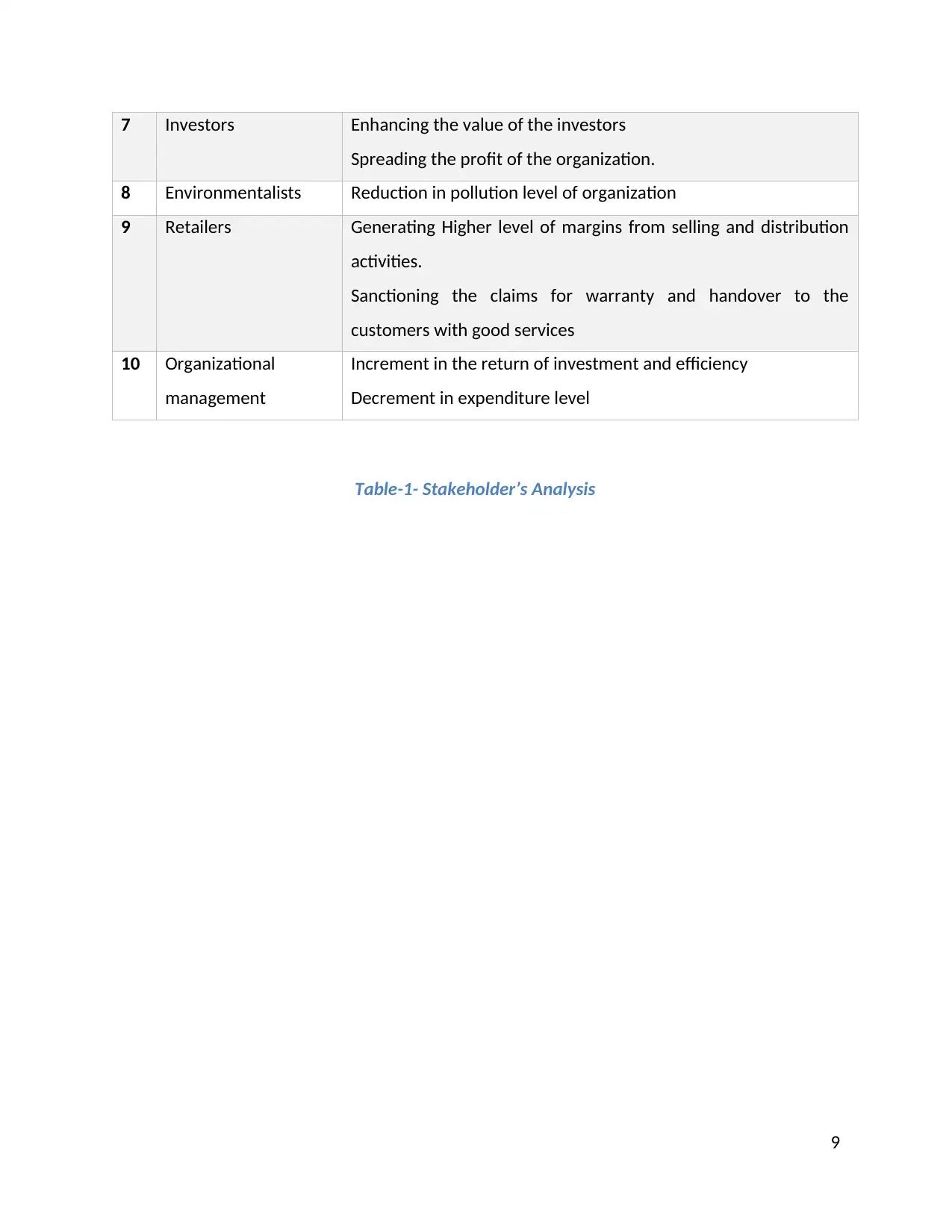
7 Investors Enhancing the value of the investors
Spreading the profit of the organization.
8 Environmentalists Reduction in pollution level of organization
9 Retailers Generating Higher level of margins from selling and distribution
activities.
Sanctioning the claims for warranty and handover to the
customers with good services
10 Organizational
management
Increment in the return of investment and efficiency
Decrement in expenditure level
Table-1- Stakeholder’s Analysis
9
Spreading the profit of the organization.
8 Environmentalists Reduction in pollution level of organization
9 Retailers Generating Higher level of margins from selling and distribution
activities.
Sanctioning the claims for warranty and handover to the
customers with good services
10 Organizational
management
Increment in the return of investment and efficiency
Decrement in expenditure level
Table-1- Stakeholder’s Analysis
9
⊘ This is a preview!⊘
Do you want full access?
Subscribe today to unlock all pages.

Trusted by 1+ million students worldwide
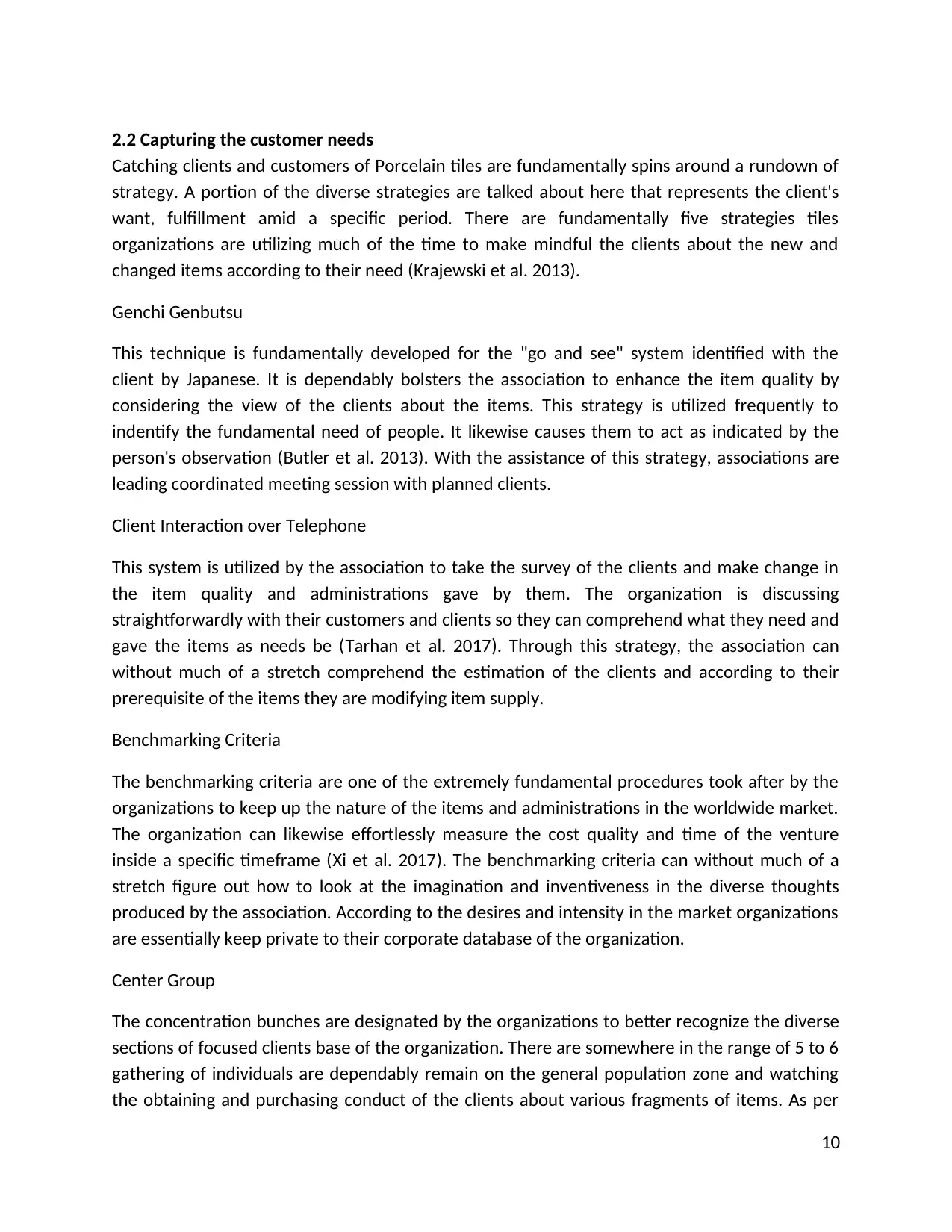
2.2 Capturing the customer needs
Catching clients and customers of Porcelain tiles are fundamentally spins around a rundown of
strategy. A portion of the diverse strategies are talked about here that represents the client's
want, fulfillment amid a specific period. There are fundamentally five strategies tiles
organizations are utilizing much of the time to make mindful the clients about the new and
changed items according to their need (Krajewski et al. 2013).
Genchi Genbutsu
This technique is fundamentally developed for the "go and see" system identified with the
client by Japanese. It is dependably bolsters the association to enhance the item quality by
considering the view of the clients about the items. This strategy is utilized frequently to
indentify the fundamental need of people. It likewise causes them to act as indicated by the
person's observation (Butler et al. 2013). With the assistance of this strategy, associations are
leading coordinated meeting session with planned clients.
Client Interaction over Telephone
This system is utilized by the association to take the survey of the clients and make change in
the item quality and administrations gave by them. The organization is discussing
straightforwardly with their customers and clients so they can comprehend what they need and
gave the items as needs be (Tarhan et al. 2017). Through this strategy, the association can
without much of a stretch comprehend the estimation of the clients and according to their
prerequisite of the items they are modifying item supply.
Benchmarking Criteria
The benchmarking criteria are one of the extremely fundamental procedures took after by the
organizations to keep up the nature of the items and administrations in the worldwide market.
The organization can likewise effortlessly measure the cost quality and time of the venture
inside a specific timeframe (Xi et al. 2017). The benchmarking criteria can without much of a
stretch figure out how to look at the imagination and inventiveness in the diverse thoughts
produced by the association. According to the desires and intensity in the market organizations
are essentially keep private to their corporate database of the organization.
Center Group
The concentration bunches are designated by the organizations to better recognize the diverse
sections of focused clients base of the organization. There are somewhere in the range of 5 to 6
gathering of individuals are dependably remain on the general population zone and watching
the obtaining and purchasing conduct of the clients about various fragments of items. As per
10
Catching clients and customers of Porcelain tiles are fundamentally spins around a rundown of
strategy. A portion of the diverse strategies are talked about here that represents the client's
want, fulfillment amid a specific period. There are fundamentally five strategies tiles
organizations are utilizing much of the time to make mindful the clients about the new and
changed items according to their need (Krajewski et al. 2013).
Genchi Genbutsu
This technique is fundamentally developed for the "go and see" system identified with the
client by Japanese. It is dependably bolsters the association to enhance the item quality by
considering the view of the clients about the items. This strategy is utilized frequently to
indentify the fundamental need of people. It likewise causes them to act as indicated by the
person's observation (Butler et al. 2013). With the assistance of this strategy, associations are
leading coordinated meeting session with planned clients.
Client Interaction over Telephone
This system is utilized by the association to take the survey of the clients and make change in
the item quality and administrations gave by them. The organization is discussing
straightforwardly with their customers and clients so they can comprehend what they need and
gave the items as needs be (Tarhan et al. 2017). Through this strategy, the association can
without much of a stretch comprehend the estimation of the clients and according to their
prerequisite of the items they are modifying item supply.
Benchmarking Criteria
The benchmarking criteria are one of the extremely fundamental procedures took after by the
organizations to keep up the nature of the items and administrations in the worldwide market.
The organization can likewise effortlessly measure the cost quality and time of the venture
inside a specific timeframe (Xi et al. 2017). The benchmarking criteria can without much of a
stretch figure out how to look at the imagination and inventiveness in the diverse thoughts
produced by the association. According to the desires and intensity in the market organizations
are essentially keep private to their corporate database of the organization.
Center Group
The concentration bunches are designated by the organizations to better recognize the diverse
sections of focused clients base of the organization. There are somewhere in the range of 5 to 6
gathering of individuals are dependably remain on the general population zone and watching
the obtaining and purchasing conduct of the clients about various fragments of items. As per
10
Paraphrase This Document
Need a fresh take? Get an instant paraphrase of this document with our AI Paraphraser
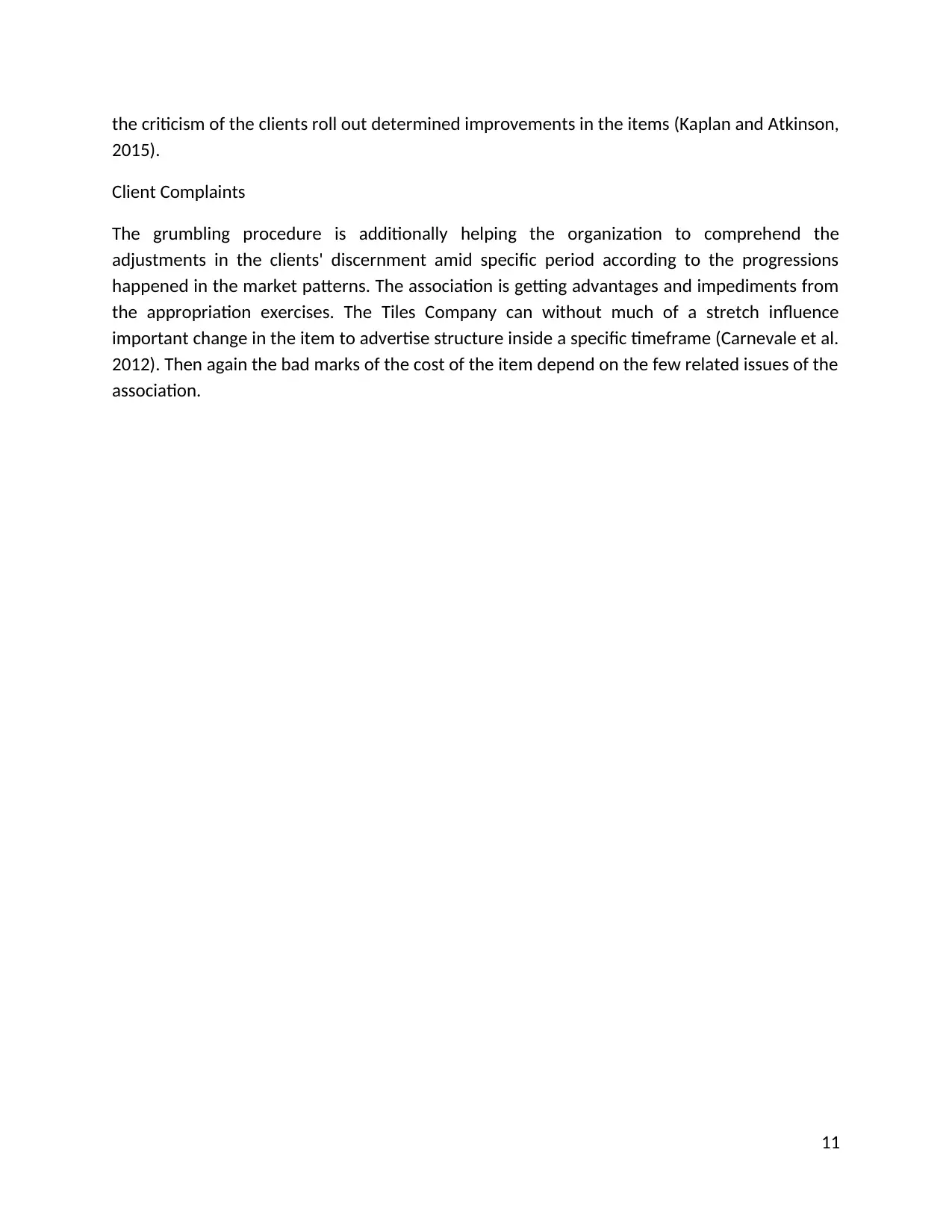
the criticism of the clients roll out determined improvements in the items (Kaplan and Atkinson,
2015).
Client Complaints
The grumbling procedure is additionally helping the organization to comprehend the
adjustments in the clients' discernment amid specific period according to the progressions
happened in the market patterns. The association is getting advantages and impediments from
the appropriation exercises. The Tiles Company can without much of a stretch influence
important change in the item to advertise structure inside a specific timeframe (Carnevale et al.
2012). Then again the bad marks of the cost of the item depend on the few related issues of the
association.
11
2015).
Client Complaints
The grumbling procedure is additionally helping the organization to comprehend the
adjustments in the clients' discernment amid specific period according to the progressions
happened in the market patterns. The association is getting advantages and impediments from
the appropriation exercises. The Tiles Company can without much of a stretch influence
important change in the item to advertise structure inside a specific timeframe (Carnevale et al.
2012). Then again the bad marks of the cost of the item depend on the few related issues of the
association.
11
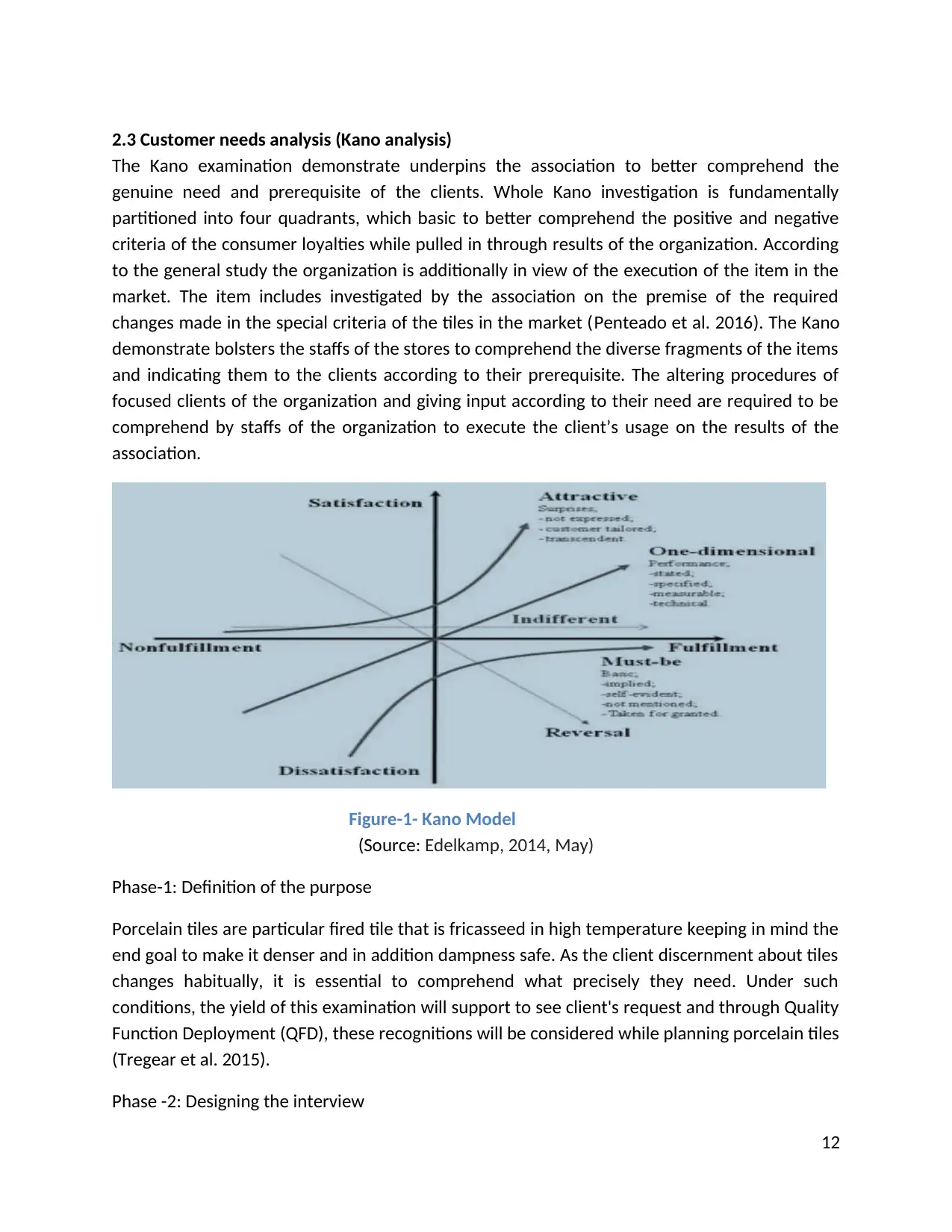
2.3 Customer needs analysis (Kano analysis)
The Kano examination demonstrate underpins the association to better comprehend the
genuine need and prerequisite of the clients. Whole Kano investigation is fundamentally
partitioned into four quadrants, which basic to better comprehend the positive and negative
criteria of the consumer loyalties while pulled in through results of the organization. According
to the general study the organization is additionally in view of the execution of the item in the
market. The item includes investigated by the association on the premise of the required
changes made in the special criteria of the tiles in the market (Penteado et al. 2016). The Kano
demonstrate bolsters the staffs of the stores to comprehend the diverse fragments of the items
and indicating them to the clients according to their prerequisite. The altering procedures of
focused clients of the organization and giving input according to their need are required to be
comprehend by staffs of the organization to execute the client’s usage on the results of the
association.
Figure-1- Kano Model
(Source: Edelkamp, 2014, May)
Phase-1: Definition of the purpose
Porcelain tiles are particular fired tile that is fricasseed in high temperature keeping in mind the
end goal to make it denser and in addition dampness safe. As the client discernment about tiles
changes habitually, it is essential to comprehend what precisely they need. Under such
conditions, the yield of this examination will support to see client's request and through Quality
Function Deployment (QFD), these recognitions will be considered while planning porcelain tiles
(Tregear et al. 2015).
Phase -2: Designing the interview
12
The Kano examination demonstrate underpins the association to better comprehend the
genuine need and prerequisite of the clients. Whole Kano investigation is fundamentally
partitioned into four quadrants, which basic to better comprehend the positive and negative
criteria of the consumer loyalties while pulled in through results of the organization. According
to the general study the organization is additionally in view of the execution of the item in the
market. The item includes investigated by the association on the premise of the required
changes made in the special criteria of the tiles in the market (Penteado et al. 2016). The Kano
demonstrate bolsters the staffs of the stores to comprehend the diverse fragments of the items
and indicating them to the clients according to their prerequisite. The altering procedures of
focused clients of the organization and giving input according to their need are required to be
comprehend by staffs of the organization to execute the client’s usage on the results of the
association.
Figure-1- Kano Model
(Source: Edelkamp, 2014, May)
Phase-1: Definition of the purpose
Porcelain tiles are particular fired tile that is fricasseed in high temperature keeping in mind the
end goal to make it denser and in addition dampness safe. As the client discernment about tiles
changes habitually, it is essential to comprehend what precisely they need. Under such
conditions, the yield of this examination will support to see client's request and through Quality
Function Deployment (QFD), these recognitions will be considered while planning porcelain tiles
(Tregear et al. 2015).
Phase -2: Designing the interview
12
⊘ This is a preview!⊘
Do you want full access?
Subscribe today to unlock all pages.

Trusted by 1+ million students worldwide
1 out of 39
Related Documents
Your All-in-One AI-Powered Toolkit for Academic Success.
+13062052269
info@desklib.com
Available 24*7 on WhatsApp / Email
![[object Object]](/_next/static/media/star-bottom.7253800d.svg)
Unlock your academic potential
Copyright © 2020–2025 A2Z Services. All Rights Reserved. Developed and managed by ZUCOL.





